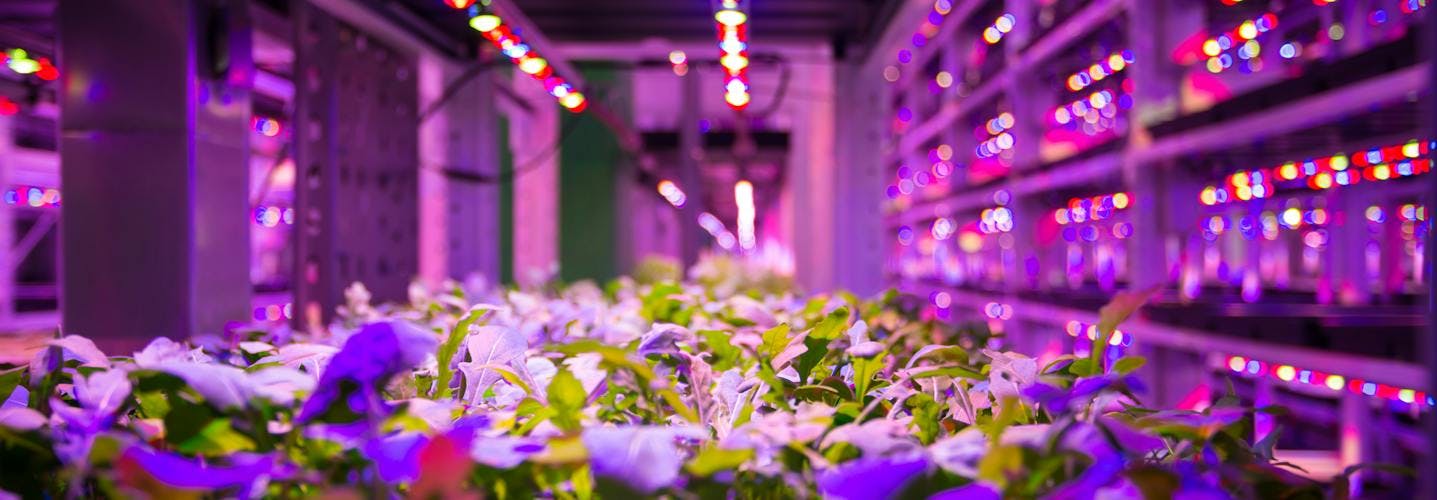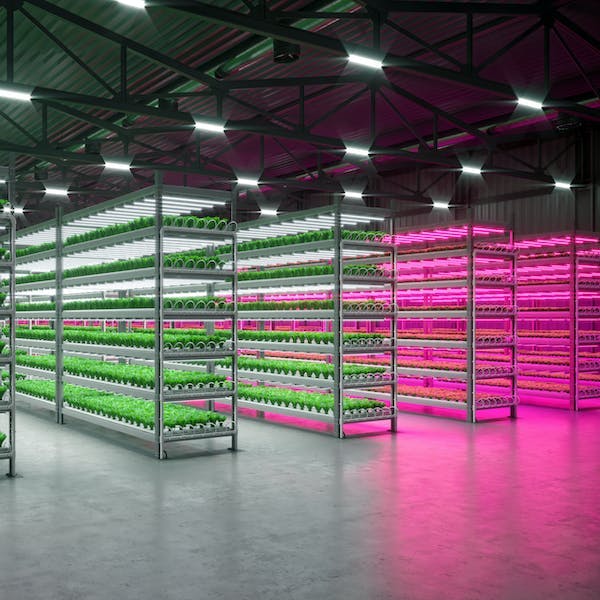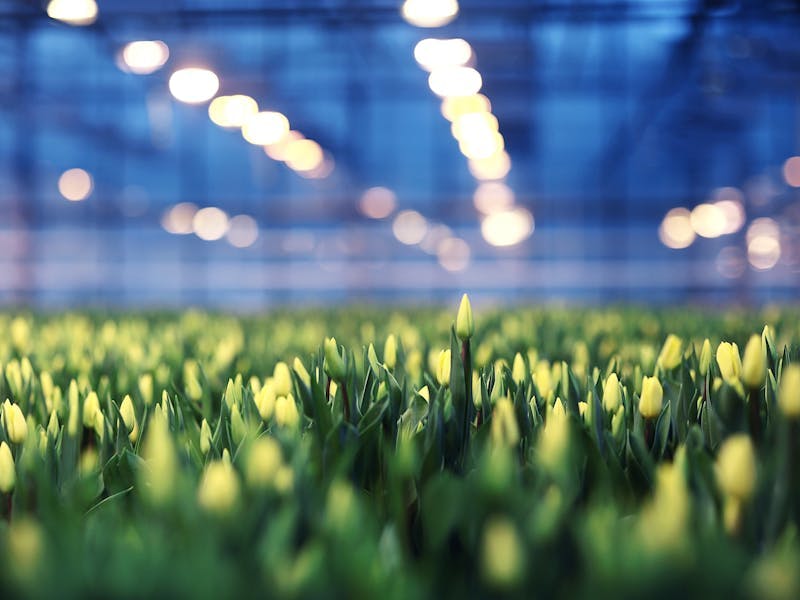
Technology to grow beyond greens
Cultures in controlled environments have seen a boom this past decade. While investments have been mostly focused on projects in the food sector, with salads and herbs as go-to products, growing more complex crops has become feasible and this opens up fields of opportunities ; it requires, however, a different approach to technology. We explore how and why in this article.
Vertical farming for food production
Vertical farming experienced an investment boom in the 2010s, with large-scale farm projects blooming near major city centers in the US, EU, Asia, and Middle East. Those large-scale plant factories and container farms have demonstrated the capacity of the technology to deliver at scale ultra-fresh vegetables – herbs and salads, mostly – year round, free of pesticides while minimizing soil footprint and water utilization. Yet, the sector still suffers from hard-to-balance economic units, in a traditionally low-margin, high-volume market.
Controlled environment ventures for food production outside leafy greens products do exist – often in berries or tomatoes – but they remain mostly experimental or address niche luxury markets. It's no surprise, though – there's a technical and expertise gap between growing a product of vegetative growth, where photosynthesis is the only key driving factor to master, and more complex crops. The latter present subtle and specific physiological mechanisms that unravel new dimensions of challenges, both technical and in the agronomy expertise required.
Approaching those new frontiers with the same mindset and technology that showed success in producing leafy greens will fail over and again. The projects that show results in growing berries or tomatoes are the ones that challenge engineering solutions and practices of the industry.
So, what makes it difficult to grow beyond herbs and greens? What are the challenges to overcome for the industry to yield results in flowering plants and other sophisticated cultures? And most importantly, what are the upsides and opportunities for those that adopt the right technical solutions?
Simple, controlled growth
At the most basic level, plants require a fitting environment for their development. An adapted climate, light source and access to the required nutrients. Traditional CEA technologies package together equipment providing those resources, and control systems to automate the whole growth process. An HVAC unit steers the climate (temperature and relative humidity), LED lights provide a substitute for sunlight, and CO2 & nutrients injectors deliver the plant with the inputs it needs.

For simple products that require only vegetative growth – that is, the growth of leaves, stems, and roots – such as salads or herbs, discovering the parameters and reproducing them in a vertical farm is now a solved problem. The optimal environment parameters are either well documented in literature or easy and fast to experiment with (cultures are typically short, allowing for fast rotation). Such plants also accommodate well enough to suboptimal settings, as long as the parameters are in the ballpark of the target range. In other words, if you give the plants roughly enough heat, light and nutrients, leaves will grow until the plants are mature enough to be picked and dispatched for consumption.
Challenges of the complex plants
Just like growing and tending to tree roses in one's garden takes a different expertise than planting salads, growing more complex plants in controlled environment settings requires a shift in perspective and technique – and a different kind of hardware.
Flowering plants, for instance, cannot blossom on vegetative growth alone ; once the plant has built enough leaf material, it requires entering a phase of generative growth where the plant directs its energy towards flower production rather than more leaves expansion. The climate and soil of endogenous flower crops provide them with a natural change of growth phase, as the seasons pass : different light exposition as the days get longer, as well as an evolving climate and precipitation rate. Emulating this phase shift is necessary to succeed in growing those flowers in a controlled environment.
At this stage, controlling the photosynthesis (light + CO2 + H2O = chemical energy) to guarantee the growth of the plant is not enough : we need to tame a chaotic physiological and biochemical balance, impacted by every environmental factor.
This is where it gets tricky : when vegetative growth requires only to approximate conditions such as temperature or light within a known range supported well by typical indoor farming hardware, the generative stage is more demanding ; both in terms of precision and specificity depending upon the type of plant and target cultivar. All the while, each specific parameter to aim for remain mostly undocumented, with discovery taking more time as growing cycles are longer : fewer experiments can be done with the same amount of time and growth real estate.
This is scratching the surface on flowering plants alone, for the simpler constituents of their growth recipe.
This fine-tuning is required for all parameters, from the spectrum of the lighting to the dynamic composition in micro and macro nutrients to deliver. Should any part of the recipe be misaligned, it creates a bottleneck for the plant as a whole, impacting on yield & quality, if not the survival of the plant itself.

Now rinse and repeat for all crop genetics, for flower plants, fruiting plants, roots production, semiaquatic plants or those that thrive in extreme climates, alpine or tropical… The diversity is staggering, and we take it as our mission with Orius to provide the technology required for supporting that diversity. We design our product portfolio around the most extreme scenarios, and we undertake plant research to offer our customers orientation protocols or turnkey recipes for the development of active ingredients.
Beyond growth, farming raw material for ingredients
Plant-based medicine and care products are millennial, and deeply ingrained in human history. Recently, the clean beauty movement and a renewed interest for phytotherapy have driven up the demand for ingredients of natural origin, used to develop those products. All the while, sourcing raw material – that is, the mature plants ready for use – for creating such ingredients has become more complex for these industries. Productions can be reliant on a season's good weather. The pandemic and geopolitical context have brought their share of complexity, on top of already high shipping costs and complex operations. All the while, precision indoor farming has become a viable alternative and can provide a local and predictable production, freed from oil-based transportation.
At Orius, the production of raw material for ingredients is our lighthouse, and we just can't stop at growth and yield. With the level of precision our technology enables, we're able to steer the plant to maximize the production of targeted secondary metabolites used for the production of drugs and cosmetics of natural origin. We want to make the plant a specialized host for the production of active compounds.
By acting on physiological mechanisms, we can boost the molecular concentration of the target compound, and deliver raw material designed for its end purpose : the production of drugs or cosmetics active ingredients.
Stay tuned, as we'll explore this topic in-depth in another article, and unravel the secrets of the plants at play. We'll also present our controlled environment systems with greater details, and show how it differs and outperforms technology built for leafy greens.